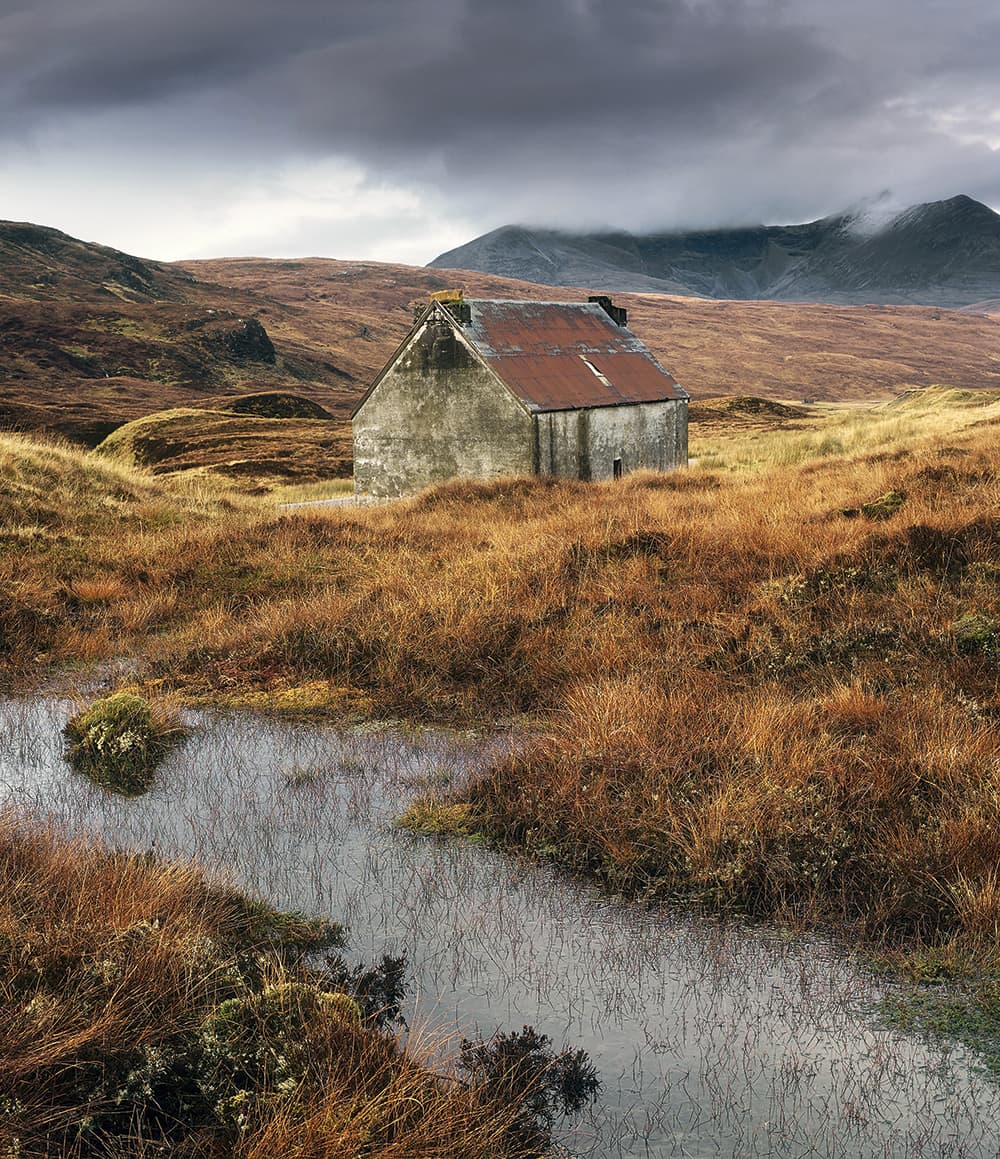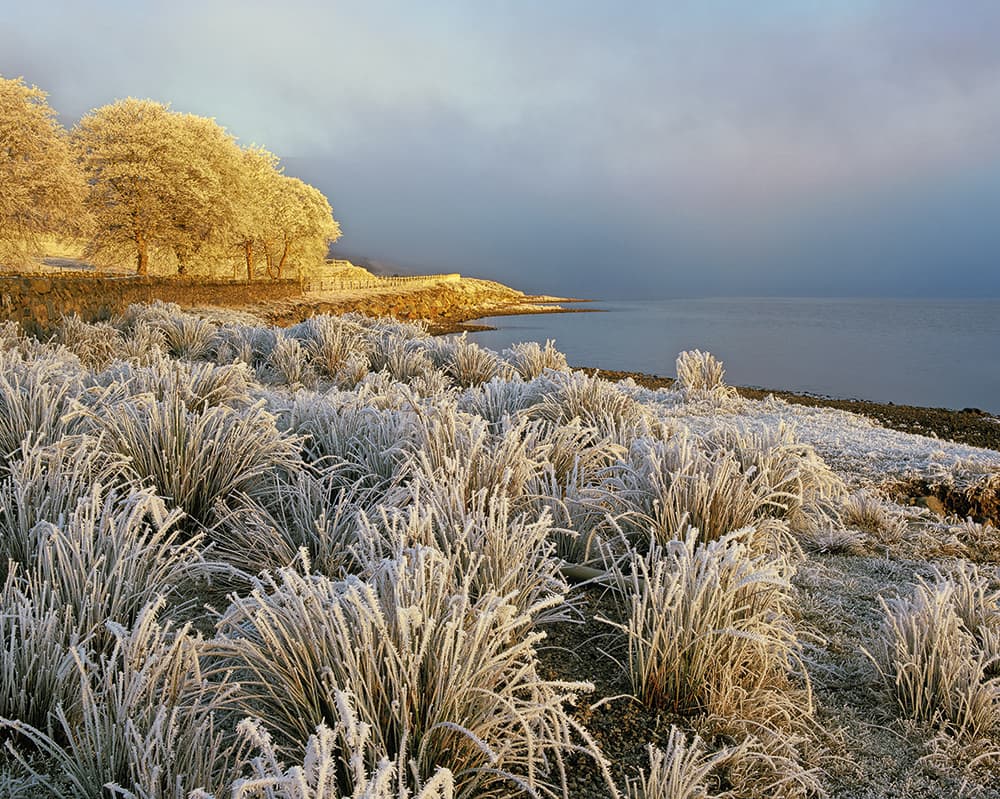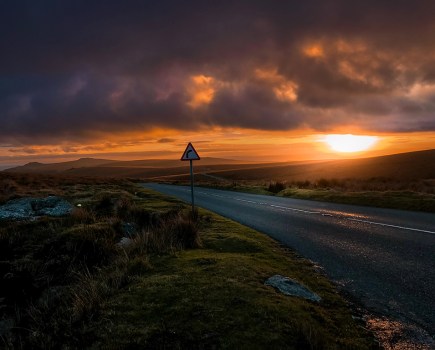Three strong scenic images are required to make up a portfolio to meet the requirements to win the title Scottish Landscape Photographer of the Year. I think I entered seven images into the 2015 competition and a number of weeks later I was informed that three of my pictures had been shortlisted. Eventually I found out I’d won.
One image is of an old house that stands on a high moorland road between Braemore Junction and Dundonnell in Wester Ross. The second is of Ben Loyal, one of Sutherland’s most shapely peaks. It is spectacularly situated in the far north of Scotland close to the lovely village of Tongue. There is a colossal estuary nearby with a massive tidal excursion and the delightfully attractive Loch Hakel, which produces superb reflections of Ben Loyal, at either end of the day. During the summer, with appropriate weather, the mountain peak lights up. On this particular morning the clear, cold night air had chilled the water and at the first warm kiss of sunlight wraiths of mist lifted off the surface adding immeasurably to the atmosphere of this classic scene.
Another image is of Loch a’ Chroisg near Achnasheen. The loch lies in an east/west direction and is surrounded by high mountains on both the northern and southern shores, effectively protecting it from the wind. On the morning I turned up the temperature was -26°C and a thick crust of hoar frost had covered every blade of grass, branch and twig such that they were bowed down by the sheer weight of ice built up over three days of sub-zero temperatures. A thick blanket of freezing mist had lifted off the loch and hung suspended in the air; from it, tiny crystals of ice were precipitating, slowly adding to the build up of frost. Out of nowhere a brilliant beam of amber sunlight scoured the shore at the far end of the loch traversing toward me and eventually striking my position.
I call light, composition and subject matter the ‘holy trinity’ of landscape photography. These three things working in perfect harmony provide the defining moment, regardless of the duration of that moment. In my opinion, light – its quality, colour, strength and direction – has the greatest influence on the success or otherwise of the pictures I take. I believe you can make a rusty nail sticking awkwardly out of a piece of wood look good in great light. It’s also worth mentioning that I don’t believe great light exists exclusively at either end of the day. Good light can be soft and directionless, colourless or colourful – it merely needs to be appropriate to the mood you want to convey.

‘Ceciles House’, between Braemore Junction and Dundonnell, Wester Ross, Scottish Highlands. Pentax 67II, 55-100mm,1sec at f/22, Fujifilm Velvia 50, 0.45ND hard edge graduated filter
Reliving the perfection
I want my pictures to transport me back to the scene as I remember it so I can relive the perfection of that moment and experience the same emotion I felt when I pressed the shutter. That picture needs to match as accurately as possible the hue, saturation and contrast that I perceived when I was there. In short, it has to be completely believable and totally realistic.
The problem is, when you seek and photograph extraordinary light and the impact it has on a scene, your believability in the eyes of others takes a severe bashing. Perhaps that is why I still insist on shooting with film, as it tends to lend credibility to an image. I don’t pretend for one instant that the colour palette of Fujifilm Velvia is entirely accurate – it isn’t – but it is at least repeatable and the results satisfy me and the screams of ‘Photoshopped’ are instantly abated when the original transparency is placed on a light box.
Out of necessity and in a professional capacity, I have to make the best of the weather and the circumstances I am dealt, although I tend to optimise my choice of location accordingly. I run photographic courses and the weather listens to no man. When I’m with clients I prefer to work in conditions that inspire them – generally that’s broken cloud and sunlight, little wind and no rain. Seemingly, I have a much more masochistic demeanour. I enjoy the challenge of managing ridiculous conditions and I achieve an enormous amount of satisfaction salvaging something wonderful from an apparently lost cause.

‘Caramel Ice’, Loch a’ Chroisg, near Archnasheen, Scottish Highlands. Pentax 6711, 55-100mm, 1/4sec at f/22, Fujifilm Velvia 50, 0.3ND hard edge graduated filter
Favourite locations
In Scotland my favourite locations are the islands of Lewis and Harris with their stunning pristine beaches; the beaches, mountains, lochs and the wild immediacy found in the mountain landscapes of Torridon; and the sheer variety and emptiness of Inverpolly in the northwest Highlands. Out of Scotland I enjoy the Lofoten Islands in Norway for their drama and exquisite light, and for a complete change the warmth and colour in the lavender fields
of Provence in France.
Ian Cameron is a landscape photographer based in Scotland. He offers various workshops and is the author of Transient Light, which can be purchased from his website for £15. If you would like to learn more, visit www.transientlight.co.uk.







